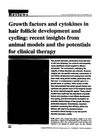TLDR Leptin may play a role in hair growth and hair follicle health.
The study revealed that human follicular papilla cells (FPC) from the scalp produced leptin, a hormone typically associated with adipose tissue, and expressed its functional receptor, suggesting a potential role for leptin in hair biology. The research involved 12 FPC lines and demonstrated leptin protein and mRNA presence in the hair follicle's lower portion. Various cytokines and growth factors were found to downregulate leptin production, indicating an autocrine function of leptin in hair biology. The findings suggested that leptin might influence hair growth and contribute to the immunoprivileged status of hair follicles, highlighting the need for further investigation into leptin's role in hair growth and biology.
105 citations
,
December 1998 in “Archives of Dermatological Research” Dermal papilla cells mainly drive blood vessel growth in hair follicles.
147 citations
,
April 1997 in “Oncogene” Overexpressing IGF-1 in mice leads to skin abnormalities and tumors.
150 citations
,
April 1997 in “Journal of Investigative Dermatology”  100 citations
,
November 1996 in “Molecular Medicine Today”
100 citations
,
November 1996 in “Molecular Medicine Today” Growth factors and cytokines are important for hair growth and could potentially treat hair loss, but more research is needed to overcome challenges before they can be used in treatments.
135 citations
,
January 1996 in “Journal of Investigative Dermatology” 219 citations
,
July 1995 in “PubMed” Keratinocyte growth factor promotes hair growth and reduces hair loss from chemotherapy.
133 citations
,
July 1994 in “Journal of Dermatological Science” Human hair growth can be influenced by certain growth factors and has specific metabolic needs.
30 citations
,
August 1993 in “PubMed” IL-1 alpha stops hair follicle growth and hair production.
58 citations
,
April 1993 in “Developmental Biology” bFGF delays hair growth in mice.
 150 citations
,
August 1992 in “Genes & Development”
150 citations
,
August 1992 in “Genes & Development” TNF alpha in skin cells causes weight loss, hair and fat issues, and skin inflammation in mice.
72 citations
,
January 1983 in “The Anatomical Record” Epidermal growth factor delays skin and hair development in mice.
31 citations
,
November 2020 in “International journal of molecular sciences” Adipokines affect skin health and could be targeted for treating skin diseases.
 October 2024 in “Biology”
October 2024 in “Biology” Dermal papilla cells can help regrow hair and are promising for hair loss treatments.
 31 citations
,
August 2015 in “Stem Cells Translational Medicine”
31 citations
,
August 2015 in “Stem Cells Translational Medicine” Human skin can provide stem cells for tissue repair and regeneration, but there are challenges in obtaining and growing these cells safely.
2 citations
,
November 2019 in “FEBS open bio” Combining specific inducers helps dermal papilla cells regain hair-forming ability.
 September 2004 in “Experimental dermatology”
September 2004 in “Experimental dermatology” Melatonin directly affects mouse hair follicles and may influence hair growth.





